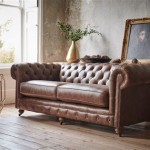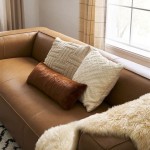What Colours Go With Brown Sofas? A Comprehensive Guide
The brown sofa is a ubiquitous piece of furniture, found in living rooms across a spectrum of interior design styles. Its popularity stems from its versatility, durability, and inherent warmth. However, determining which colours complement a brown sofa effectively can be a daunting task. Success hinges on understanding the nuances of colour theory, considering the specific shade of brown in question, and aligning the chosen palette with the desired atmosphere of the space.
Brown, in its essence, is a neutral colour, a composite of red, yellow, and black. This inherent complexity gives rise to a wide range of browns, from light tans and beiges to deep chocolates and espressos. Each variation possesses distinct undertones that subtly influence its interaction with other colours. Therefore, a blanket statement about "brown" is insufficient when making decorating decisions. A careful assessment of the sofa's specific hue is paramount.
Furthermore, the texture of the sofa plays a role. A smooth leather sofa will reflect light differently than a textured fabric sofa, impacting how colours appear in the room. The lighting within the space, both natural and artificial, will also influence the perceived colour of the sofa and its surrounding elements. These factors necessitate a holistic approach to colour selection, extending beyond simply pairing colours in isolation.
Understanding Brown Undertones
The first step in selecting complementary colours is to identify the undertones present in the brown sofa. Undertones are the subtle hues that underlie the primary colour and are often discernible in different lighting conditions. Brown sofas commonly exhibit undertones of:
- Warm Undertones (Red, Orange, Yellow): These browns tend to feel cozy and inviting. They pair well with other warm colours but can also create a striking contrast with cool colours. Think of terracotta, rust, and golden browns.
- Cool Undertones (Blue, Green, Gray): These browns possess a more sophisticated and grounding quality. They often lean towards taupe or mushroom shades. They complement cool colours and can be warmed up with accents of warm hues.
- Neutral Undertones: These browns are balanced and versatile, making them relatively easy to coordinate with a wide range of colours. They are true browns without a dominant warm or cool persuasion.
Determining the undertone can be achieved by comparing the sofa to swatches of known warm, cool, and neutral colours. Natural daylight provides the most accurate assessment. Once the undertone is identified, it serves as a guide for navigating the colour wheel.
Failure to recognize and address the undertones can result in a colour scheme that feels discordant and unbalanced. For example, pairing a brown sofa with cool undertones with overly warm colours might create a clash rather than a harmonious blend.
Complementary Colour Palettes for Brown Sofas
Armed with an understanding of the sofa's specific shade and undertones, the next step involves exploring suitable colour palettes. The choice of palette should reflect the desired mood and style of the room. Here are several options, categorized by their overall effect:
Monochromatic Palette:
A monochromatic palette utilizes different shades and tints of the same colour. For a brown sofa, this could involve incorporating variations of brown, beige, and cream throughout the space. Walls could be painted a light beige, while accent chairs and cushions could feature darker shades of brown. This creates a cohesive and calming atmosphere, emphasizing texture and subtle variations rather than bold contrasts.
The key to a successful monochromatic scheme lies in layering different textures and materials to prevent the space from feeling flat or monotonous. Think of incorporating natural materials like wood, linen, and wool to add depth and visual interest.
Analogous Palette:
An analogous palette employs colours that are adjacent to each other on the colour wheel. For a brown sofa with warm undertones, analogous colours might include oranges, yellows, and reds. These colours can be used for accent walls, artwork, and accessories. This palette creates a warm and inviting atmosphere, evoking feelings of comfort and energy.
For a brown sofa with cool undertones, analogous colours might comprise blues, greens, and purples. These colours can be incorporated through wall paint, area rugs, and decorative items. This palette creates a serene and sophisticated ambiance, reminiscent of nature and tranquility.
Complementary Palette:
A complementary palette features colours that are opposite each other on the colour wheel. The complementary colour of brown is blue. Pairing a brown sofa with blue walls, accessories, or artwork can create a visually striking and balanced contrast. The specific shade of blue should be chosen based on the brown's undertone. For example, a warm brown pairs well with a cool, crisp blue, while a cool brown harmonizes with a warmer, softer blue.
While complementary colours can create a dynamic effect, it is important to use them in moderation. Overuse of complementary colours can be overwhelming. It’s generally recommended to use one colour as the dominant hue and the other as an accent.
Neutral Palette:
A neutral palette consists of colours that are considered achromatic or nearly so. These include white, gray, black, and beige. A neutral palette provides a versatile backdrop that allows the brown sofa to stand out. It also allows for the incorporation of pops of colour through accessories and artwork. Gray walls, white trim, and black accents can create a sophisticated and modern look when paired with a brown sofa.
The key to a successful neutral palette is to incorporate a variety of textures and materials to add depth and visual interest. Consider using different shades of gray, from light dove gray to dark charcoal gray. The introduction of metallic accents, such as gold or silver, can also add a touch of elegance and glamour.
Practical Applications and Considerations
Beyond the overarching colour palette, several practical considerations influence the successful integration of colours around a brown sofa:
Wall Colour:
The colour of the walls has a significant impact on the overall ambiance of the room. Light-coloured walls, such as off-white or pale gray, can make a small room feel larger and brighter. Dark-coloured walls, such as deep blue or charcoal gray, can create a cozy and intimate atmosphere. The choice of wall colour should be carefully considered based on the size of the room, the amount of natural light available, and the desired mood.
When selecting a wall colour, it is beneficial to obtain paint samples and test them in the room under different lighting conditions. The colour may appear different in daylight than it does under artificial light. It is also helpful to consider the colours of the flooring and other fixed elements in the room to ensure a cohesive and harmonious design.
Accent Colours:
Accent colours are used to add visual interest and personality to a space. They can be incorporated through cushions, throws, artwork, and accessories. When selecting accent colours, consider the colour palette of the room and the desired mood. For example, bright and bold accent colours, such as yellow or orange, can add energy and excitement to a space. Soft and muted accent colours, such as lavender or sage green, can create a calming and relaxing atmosphere.
The use of a colour wheel can be helpful in selecting accent colours that complement the brown sofa and the overall colour scheme. Complementary colours, analogous colours, and triadic colours are all options to consider.
Textural Elements:
Texture plays a crucial role in adding depth and visual interest to a space. Different textures can be introduced through fabrics, rugs, and decorative items. A room with a brown sofa can benefit from the addition of textured cushions, such as velvet, linen, or faux fur. A textured rug can also help to ground the space and add warmth. Consider incorporating natural materials, such as wood, stone, and metal, to further enhance the textural richness of the room.
When selecting textural elements, consider the overall style of the room. A modern room might benefit from sleek and minimalist textures, while a traditional room might benefit from more ornate and detailed textures. The interplay of different textures can create a visually appealing and tactilely engaging space.
Ultimately, the best colours to pair with a brown sofa depend on individual preferences and the specific characteristics of the space. However, by understanding the principles of colour theory, considering the sofa's undertones, and carefully planning the overall colour scheme, it is possible to create a harmonious and aesthetically pleasing living environment.

What Color Goes With A Brown Leather Sofa Studio34

10 Brown Sofa Combinations Ideas Living Room Colors

What Color Go With Brown Sofa Quora

What Colour Cushions Go With A Brown Sofa Furn Com

What Colors Go With Brown 19 Stunning Color Pairings

Which Colours Go With A Brown Leather Sofa Houzz

How To Style What Colours Go With A Brown Sofa Swyft

What Colours Go Best With A Brown Sofa Furniture Blog

What Colour Cushions Go With A Brown Sofa Furn Com

Ideas For Wall Colors That Go With Brown Furniture The Inside








